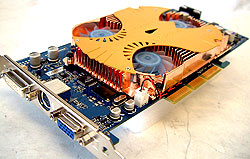While I'd still say the Radeon 9800 Pro is faster
overall, it certainly seems like nVIDIA is on the right track with their
GeForceFX 5900/5900 Ultra line of GPU's. With TSMC's 0.13 micron teething
problems pretty much gone, nVIDIA's biggest problem now will be dealing with the
huge supply demands.

nVIDIA did address probably the biggest issue with the
GeForceFX 5800/5800 Ultra and that's the narrow 128bit memory bus. With the FX
5900's memory bus expanded to 256bits, the GPU is no longer memory bandwidth
limited like it was on the NV30.
Those of you who are still screaming about the 4 pixel
single texture pipeline should really calm down as newer games are all
multi-textured and there the GeForceFX 5900/5900 Ultra can play with the big
boys.
One thing that we really liked is that nVIDIA has
incorporated an internal diode so gamers/enthusiasts can see how hot their
videocards get.
Albatron have done a very good job with the FX5900PV
- the card is shipped in a very cool looking notebook style bag that can be
reused for many different purposes. A small software bundle is included
which consists Duke Nukem: MP, a five game lite/demo CD, Power Director and
Power DVD. Because the Albatron GeForceFX 5900PV is VIVO capable, a VIVO
break out box as well as a composite-to-composite and S-Video-to-S-Video cable
are thrown in. For those of you who want to use dual monitors, Albatron also
include a DVI-to-analog converter.
Performance of the Albatron GeForceFX 5900PV was very
good, on average it performed in the benchmarks close to that of the Radeon
9700 Pro but sometimes it would even outperform the Radeon 9800 Pro.
The card did exceptionally well in the Gun Metal 2
benchmark which is the only real world DirectX 9 benchmark in our suite at the
moment. Is this a sign of things to come? We're sure as the NV35 matures,
drivers will be able to draw more performance out of the card. Hopefully that
will be done before the next generation chips are available.
Overclocking the Albatron GeForceFX 5900PV was quite
frustrating because of the built in nVidia thermal management; when the
card started to overheat it would downclock itself automatically within the
benchmarks! Individually, the core would do a nice 500 MHz and by itself the
memory would hit 1 GHz! However, running both the core and memory overclocked at
the same time produced some pretty disheartening results. The highest we were
able to hit with both core and memory overclocked was 466 MHz core and 975 MHz
memory which is still pretty good.
If you're in the market for a new high end videocard I'd
have to suggest you get a Radeon 9800 Pro based videocard still. Overall I'd say
it's faster and it costs less. GeForceFX 5900 Ultra based videocards
are not as good a value (relatively) because the only difference is the
slightly higher core clock speeds (450 MHz on the Ultra as opposed to 400 MHz on
the FX5900 regular). If you're a die hard nVIDIA fan and ATi is not an option
then the Albatron GeForceFX 5900PV is a very good choice.
Find out about this and many other reviews by joining the
Weekly PCstats.com Newsletter today!
Related Articles
Here are a
few other articles that you might enjoy as well...
1. Albatron GeForceFX 5600P Turbo Videocard
Review
